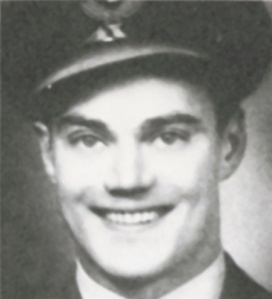
Pic: Bomber Command Museum of Canada
Flg Off R A Urquhart DFC
Navigator
Lancaster serial number: ED937/G
Call sign: AJ-Z
First wave. Second aircraft to attack Eder Dam. Mine overshot. Aircraft damaged, and shot down on return flight.
Robert Alexander Urquhart was born in Moose Jaw, Saskatchewan, Canada on 2 August 1919, one of the four children of Alexander and Susie Urquhart. His father worked as a clerk. Urquhart himself was educated at local schools and then worked as an apprentice jeweller and a stock manager before the war. He applied to the RCAF in May 1940 and joined up in January 1941. He was initially selected for pilot training and finally qualified as a navigator with a commission in January 1942.
He arrived in England in March 1942, and underwent further training. At one point he flew with Joe McCarthy, later a 617 Squadron colleague. He joined 50 Squadron in August 1942 and undertook fifteen operations with Sqn Ldr Moore as pilot. On 17 December 1942 he joined another crew, piloted by Sqn Ldr Birch, in a raid on Soltau. Richard Trevor-Roper was Birch’s regular rear gunner and flew on this operation.
In the New Year, he teamed up with Henry Maudslay almost immediately after Maudslay resumed operational flying in 50 Squadron in January 1943. Maudslay and Uquhart’s first operation together was to Essen on 21 January 1943, and they flew another eleven operations together until the whole crew was posted into 617 Squadron on 25 March 1943.
On 4 April Maudslay, Urquhart and three others flew to Farnborough and stayed there several days while two Aldis lamps were fitted to enable the pilot to maintain the correct height for the attack on the dams. The navigator was given the important task of looking through the blister and checking that their beams were touching. On their return to Scampton, Maudslay and Urquhart made test runs across the airfield and then later the same evening at Skegness and in the Wash, demonstrating they could successfully keep to the required height.
By the time of the Dams Raid, Urquhart had amassed twenty-eight operations and had been cited for a DFC for his operational flying in 50 Squadron. The citation read:
Since joining this squadron, Flying Officer Urquhart has flown on many operations. At all times his navigation has been of the highest order and the successes he achieved are due in no small measure to his skill. This officer took part in the daylight raids on Le Creusot and Milan and at other times on many heavily defended German targets. On one occasion during a low level raid on a target in North West Germany he was wounded by anti-aircraft fire but continued to navigate with accuracy. By his skill and determination Flying Officer Urquhart has set a high standard among his fellow navigators.
In fact the recommendation had been made originally on 20 March 1943 by the Commanding Officer of 50 Squadron, and endorsed by Air Vice Marshal Cochrane on 4 May 1943. Unfortunately the paperwork got ‘lost’ in the corridors of officialdom until the closing stages of the war. The Canadian Minister of National Defence for Air wrote to the Urquhart family on 30 July 1945, apologising for the delay in the award and enclosing his ‘Operational Tour Wings’ and certificate. His DFC was eventually sent by registered mail on 7 November 1949, along with the Canadian War Memorial Cross.
When they got to AJ-Z’s crash site, the Germans could not identify the individual remains of Urquhart, Tytherleigh and Fuller, and they were buried together in a collective grave in Düsseldorf North Cemetery. After the war, the whole crew was reinterred in Reichswald Forest War Cemetery.
[Thanks to Simon Muggleton for help with this post.]
More about Urquhart online:
Commonwealth War Grave Commission entry
Canadian Virtual War Memorial
Bomber Command Museum of Canada
Entry at airforce.ca website, including DFC citation (scroll down)
Auction details of his medals and logbook (includes short biography)
KIA 17.05.43
Rank and decorations as of 16 May 1943.
Sources:
Robert Owen, Steve Darlow, Sean Feast and Arthur Thorning, Dam Busters: Failed to Return, Fighting High 2013
Robert Owen, Henry Maudslay, Fighting High 2014
Richard Morris, Guy Gibson, Penguin 1995
John Sweetman, The Dambusters Raid, Cassell 2002
 Further information about Robert Urquhart and the other 132 men who flew on the Dams Raid can be found in my book The Complete Dambusters, published by History Press in 2018.
Further information about Robert Urquhart and the other 132 men who flew on the Dams Raid can be found in my book The Complete Dambusters, published by History Press in 2018.





 Further information about Robert Urquhart and the other 132 men who flew on the Dams Raid can be found in my book
Further information about Robert Urquhart and the other 132 men who flew on the Dams Raid can be found in my book 

